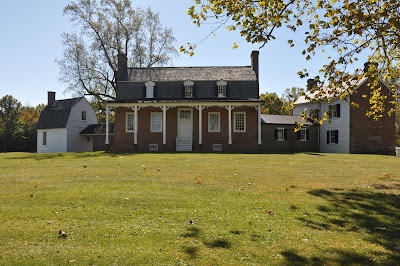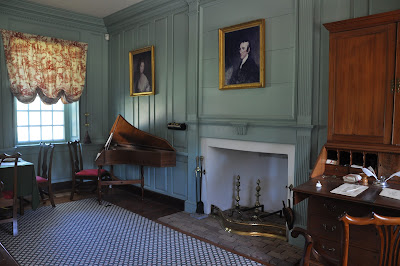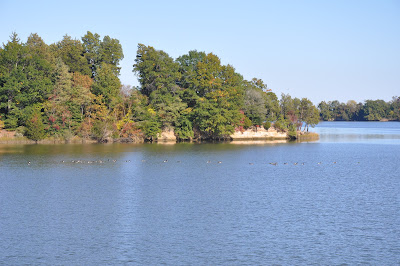This morning we checked out of our hotel in downtown DC and took I-395 S to I-695 E across the Anacostia River to I-295 S. Once we entered Maryland, we continued south on MD-210 to our first destination of the day, Fort Washington Park. This checks off my 200th park visited, and it just so happens to be celebrating its 200th anniversary this year. How cool is that?!
We arrived just before 8:45AM, but visitor center was not open yet, so we poked around the inside of the fort on our own.
Fort Warburton was completed on this site in 1809 and guarded the Potomac River approach to Washington, DC until it was destroyed by its own garrison in 1814 when the British invaded the capital during the War of 1812. Construction of Fort Washington began within a matter of weeks and was finally completed in 1824. The first guns were mounted in 1846. During the Civil War, a circle of temporary forts were built around the capital to augment its defenses. Up until then, Fort Washington had been the sole defense of the District of Columbia.
 |
| Looking back through the sally port at the visitor center |
 |
| Soldiers' barracks |
 |
| Mount Vernon in the distance on the opposite side of the Potomac River |
From 1890-1910, the Endicott system was implemented to improve coastal defenses. Completed in 1891, Battery Decatur was the first modern artillery position built for the defense of Washington, DC. It utilized disappearing 10-inch guns and reinforced concrete emplacements. These structures look similar to other Endicott era defenses we've seen in our travels, including Fort Warren (MA), Fort Wadsworth (NY), Fort Stevens (OR), Fort Canby (Cape Disappointment, WA), Fort Columbia (WA), and Fort Casey (WA).
We stopped by the visitor center on our way back to the car. Although the building itself was closed for repairs, there were rangers on the porch outside, along with a cache of passport stamps. We left the park around 10:00AM, but we had to stop to take a pic of this gorgeous tree on the way out!
 |
| Wow! |
Our next stop was just across the creek from Fort Washington, but it actually took us more than 20 minutes to get to Piscataway Park. Established in 1961 to protect the viewshed across the Potomac River from Mount Vernon from development, today the National Park Service partners with the Accokeek Foundation, Alice Ferguson Foundation, and other agencies to manage the park.
 |
| ☑ Unit #201 |
 |
| The view of Mount Vernon from the fishing pier |
After stopping by the visitor center, we hiked the Riverview Trail to the National Colonial Farm, an outdoor living history museum representing a typical tobacco farm from the 1770s. The domesticated livestock at the farm are rare heritage breeds with unique genetic traits, including American Milking Devon cattle, Ossabaw Island hogs, Hog Island sheep, Java chickens, and Jersey Buff turkeys.
 |
| Tobacco barn |
 |
| Livestock barn |
 |
| Hog Island sheep |
There were several stamps in common between Fort Washington Park and Piscataway Park, so our unique stamp totals for the NPTC Master Traveler Award only increased to:
Units: 67
Stamps: 189
Regions: 6
Altogether we spent just under an hour here at Piscataway Park and then were back on the road again around 11:15AM. Because we needed to get to Thomas Stone National Historic Site for a ranger-led tour at 1:00PM, we grabbed some fast food in Bryan Road, MD to eat in the car on the way, arriving at the park close to noon.
 |
| ☑ Unit #202 |
So, who was Thomas Stone?
Born in 1743 in Charles County, MD, Thomas Stone was an affluent landowner, slaveholder, and lawyer. He represented Maryland at the Second Continental Congress and, most notably, was one of the 55 signers of the Declaration of Independence. In 1770, he purchased the 442-acre plantation "Haberdeventure" from his uncle as a place to raise his family, and it remained in the Stone family until the 1930s. Established by Congress in 1978, Thomas Stone NHS commemorates and honors the man who pledged his "life, fortunes, and sacred honor" in support of the cause of freedom.
Since we had plenty of time before the tour started, we went through the exhibits in the visitor center after getting the passport stamps (8 stamps | 2 units). There was an interesting set of displays on the roots of religious freedom in Southern Maryland, starting with its founding on the ideal of a religiously tolerant colony of Catholics and Protestants by the Calverts in the 1630s. Over the next century and a half, however, echoes of the shifting politics and religious rivalries in England were felt in the colonies. William Stone, the great-great-grandfather of Thomas, was the first Protestant governor of Maryland, appointed in 1648 by Cecilius Calvert, Lord Baltimore.
Once we finished up in the visitor center, we headed out the rear entrance to walk the short trail to the family cemetery.
 |
| Thomas Stone 1743-1787 |
Then we followed the mowed path through the field to the Thomas Stone House. While waiting for the ranger to arrive, we walked over to see the outbuildings.
 |
| North face of the curved five-part colonial house |
 |
| Corn crib (left) and tobacco barn (right) |
 |
| Curing tobacco |
The ranger started the tour promptly at 1:00PM and brought us inside the house. In 1977, a fire gutted the central block of the house. It has been restored to its earliest known configuration, as seen in a photograph from 1902. The house was opened to the public in 1997.
 |
| North kitchen |
 |
| Main bedroom |
 |
| East Room parlor |
 |
| East Room parlor |
 |
| From left: west wing kitchens, west hyphen, central block, east hyphen, east wing |
The tour lasted a little over 30 minutes. Afterwards, we walked back to the visitor center and then hopped into the car for the 40-mile drive to our last stop for the day. We crossed over into Virginia (toll bridge) and arrived at George Washington Birthplace National Monument just before 3:00PM.
 |
| ☑ Unit #203 |
When I was planning out our itinerary, it was clear that we wouldn't be able to make the ranger program at the Memorial House Museum given the timing of everything else today. But that wasn't a dealbreaker because we knew that there wasn't anything historically tied to George Washington inside.
In fact, while the national monument is situated on the land which was part of the Washington family's farm, the Colonial Revival structures here were actually built in the 1930s by the Wakefield National Memorial Association to commemorate his 200th birthday. They were constructed to be suggestive of a colonial farm complex, but none were based on historical or archeological evidence of the buildings that existed here in the 1700s. The house in which George Washington was born is no longer standing.
In 1896, the United States War Department placed an obelisk at the site believed to be the location of George Washington's birth house. At 50 feet tall, it is about one-tenth the size of its counterpart in Washington, DC. It was relocated to the entrance of the park in 1931 when the Memorial House Museum was built.
 |
| Memorial obelisk |
After our usual visitor center routine of viewing exhibits and getting passport stamps (8 stamps | 2 units), we hiked the trail alongside Popes Creek around the Cedar Grove to the Memorial Area.
 |
| Canadian geese on Popes Creek |
 |
| Colonial Revival Garden |
 |
| Lucy's Bridge across Dancing Marsh |
During construction of the Memorial House Museum, archeologists excavated a Colonial-era brick foundation. After it had been fully unearthed, further investigation suggested that this might have been the original location of George Washington's birth home. But since it could not be definitively identified, the site was named "Building X". Most recently, the foundation was opened again for reexamination in 2022, revealing that a substantial 18th century gentry family home that belonged to the Washingtons once stood here. The outline marks the remains of the foundation.
 |
| Building X |
We only spent a little over an hour here, but I think it was definitely sufficient to count this as a visit. And our running total for passport stamps in 2024 is now at:
Units: 71
Stamps: 200
Regions: 6
Then we were back on the road to finish the last 40 miles of our Sunday drive on VA-3 and VA-218 to Fredericksburg, rounding out the day with a tasty dinner at Paradise Diner and laundry back at the hotel.
 |
| Souvlaki, country fried steak and eggs with a side of grits |
 |
| 125 miles, 3 hours |











No comments:
Post a Comment